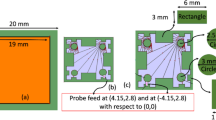Abstract
Based on the measurements for a GEO-mobile radio-1 third generation (GMR-1 3G) handset with different external antennas in free space as well as with the head and hand setups, effects of the antenna patterns on a satellite forward link radio channel are studied in this paper. When merging the antenna gain patterns into Rayleigh and Ricean channels proposed in GMR-1 3G standard, it’s found that the received power in satellite forward link has big deviation from original Rayleigh and Ricean distributions. At the same time, the performances for different external antennas are evaluated, it’s found that helix octafilar with 16 mm diameter is much better than other external antennas which are aimed to be directed to a specific angular range in the elevation plane for a geo-satellite mobile system.






Similar content being viewed by others
References
Zhao, X., Kivinen, J., & Vainikainen, P. (2003). Characterization of Doppler spectra for mobile communications. IEEE Transactions on Vehicular Technology, 52(2), 14–23.
Kivinen, J., Zhao, X., & Vainikainen, P. (2001). Empirical characterization of wideband indoor radio channel at 5.3 GHz. IEEE transactions on antennas propagation, 49(8), 1192–1203.
Geng, S., & Vainikainen, P. (2009). Mm-wave propagation in indoor corridors. IEEE Antennas and Wireless Propagation Letters, 8, 1242–1245.
GMR-1 3G 45.005, ETSI TS 101 376-5-5, v3.1.1 (2009). GEO-mobile radio interface specifications (Release 3); Third generation satellite packet radio service; Part 5: Radio interface physical layer specifications; Sub Part 5: Radio transmission and reception.
Yin, X., Ling, C., & Kim, M. D. (2015). Experimental multipath-cluster characteristics of 28-GHz propagation channel. IEEE Access, 3, 3138–3150.
Zhao, X., et al. (2017). Channel measurements, modeling, simulation and validation at 32 GHz in outdoor microcells for 5G radio systems. IEEE Access, 5, 1062–1072.
Arapoglou, P. D., Michailidis, E., Panagopoulo, A. D., Kanatas, A. G., & Prieto-Cerdeira, R. (2011). The land mobile earth-space channel: SISO to MIMO modeling from L- to Ka-bands. IEEE Vehicular Technology Magazine, 6(2), 44–53.
Erceg, V., et al. (1997). Comparisons of a computer-based propagation prediction tool with experimental data collected in urban microcellular environments. IEEE Journal on Selected Areas in Communications, 15(4), 677–684.
Acknowledgements
This work is supported by the Department of Science and Technology, State Grid, China. Thank Mr. Liang Li for helping us to format the final version of this paper.
Author information
Authors and Affiliations
Corresponding author
Rights and permissions
About this article
Cite this article
Wang, Y., Zhao, X. Effect of External Antenna Patterns for a GMR-1 3G Handset on Satellite Forward Link Radio Channels. Wireless Pers Commun 97, 153–161 (2017). https://doi.org/10.1007/s11277-017-4498-3
Published:
Issue Date:
DOI: https://doi.org/10.1007/s11277-017-4498-3




